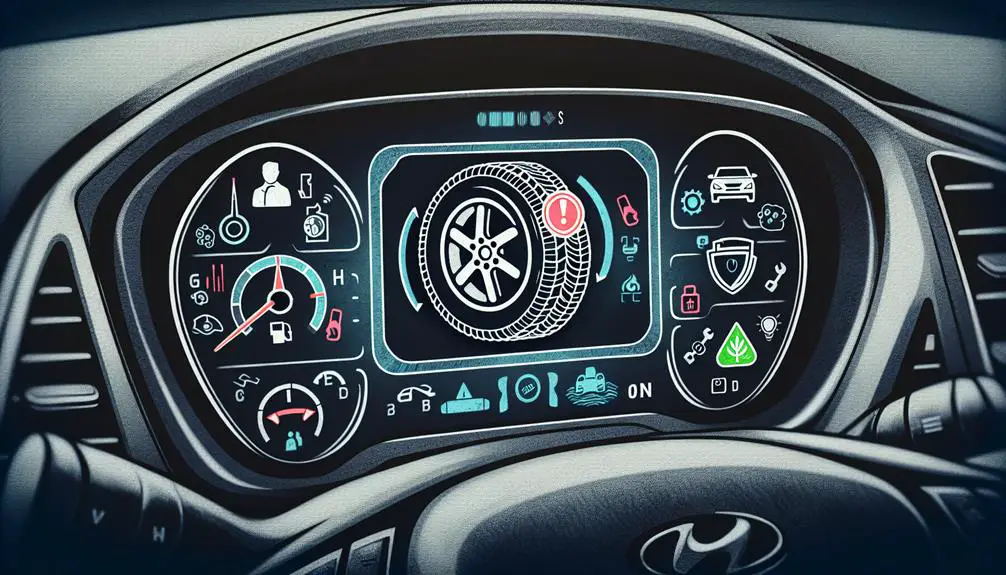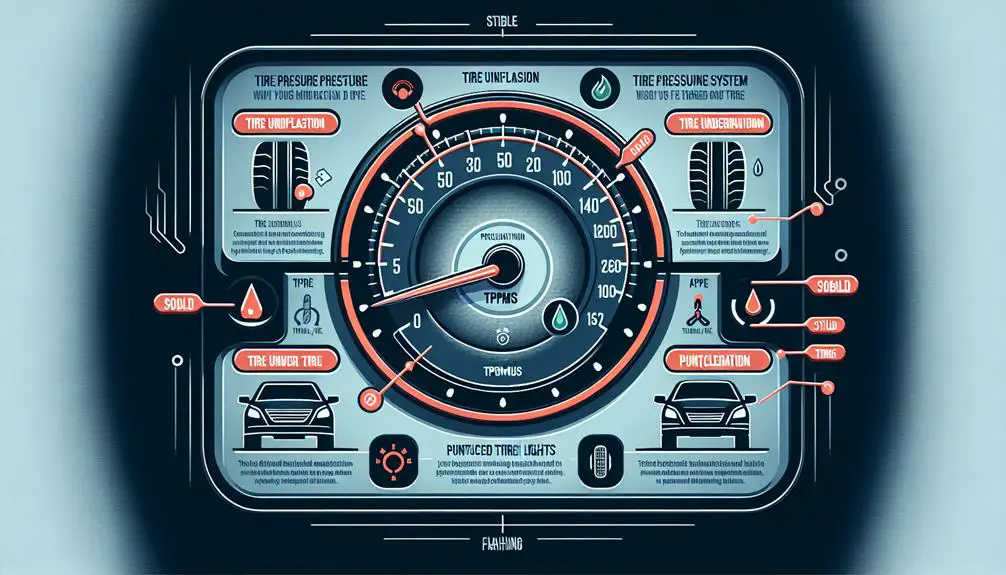To monitor and reset your Hyundai’s TPMS, observe the dashboard warning light for low tire pressure.
To reset, typically press a button on the dash or through the vehicle settings menu.
If the light persists, check all tires for proper inflation, including the spare, and adjust as necessary.
No special tool is required for resetting; however, if issues persist, professional assistance may be needed.
What is TPMS in Hyundai Vehicles?

The Tire Pressure Monitoring System (TPMS) in Hyundai vehicles is designed to enhance safety and fuel efficiency by monitoring tire pressure.
TPMS alerts drivers to low tire pressure, reducing the risk of flat tires and accidents, and improving tire lifespan and fuel economy.
When a tire’s pressure drops, the system notifies the driver through the dashboard display, enabling prompt action to maintain optimal tire condition.
This feature not only contributes to vehicle safety but also offers economic benefits by promoting even tire wear and reducing fuel consumption.
How Does Hyundai TPMS Work?
Hyundai’s Tire Pressure Monitoring System (TPMS) monitors tire air pressure and alerts drivers to pressure drops.
The system comprises sensors in each tire that measure pressure and communicate with the vehicle’s computer. If a sensor detects pressure below a predetermined threshold, it triggers a dashboard alert, prompting the driver to take action.
This ensures tires remain properly inflated, improving safety, fuel efficiency, and tire longevity.
Why is Your Hyundai TPMS Light On?

Your Hyundai’s TPMS light is on due to potential tire pressure issues or system malfunction.
The TPMS light illuminates when there’s a drop in tire pressure, possibly from natural air loss, temperature changes, or a puncture.
A solid light indicates low tire pressure, while a flashing light suggests a malfunction in the TPMS system, such as a failing sensor battery or monitoring issues.
Ignoring this light can lead to tire damage and compromise vehicle safety. Addressing the cause promptly ensures safe and efficient driving.
How to Check Tire Pressure in Hyundai Vehicles
Step 1:
Ensure your tires are ‘cold’ before checking the pressure. This means the car hasn’t been driven for at least three hours to prevent heat from affecting the pressure readings.
Step 2:
Locate the recommended tire pressure for your Hyundai model. This information can typically be found on a sticker inside the driver’s door jamb or in your vehicle’s manual. Note that the recommended pressure may vary for the front and rear tires.
Step 3:
Acquire a reliable tire pressure gauge. These tools are affordable and readily available at auto parts stores.
Step 4:
Remove the valve cap from one of your tires. Firmly press the gauge onto the valve to measure the pressure. Read the measurement and compare it to the recommended pressure for your vehicle.
Step 5:
If the tire pressure is too low, add air until you reach the recommended pressure level. If the pressure is too high, release some air and then recheck the pressure.
Step 6:
Repeat the process for all four tires, ensuring each is checked and adjusted as necessary to match the recommended pressure.
Step 7:
Don’t forget to check and adjust the pressure of your spare tire. Although it’s often overlooked, maintaining the correct pressure in the spare is crucial for emergency use.
How to Reset the TPMS on Hyundai Vehicles?

Step 1:
Ensure all tires, including the spare, are inflated to the recommended pressure. This is crucial for the TPMS to accurately monitor tire pressure.
Step 2:
Turn the ignition to the ‘ON’ position, but don’t start the engine. This will activate the vehicle’s electrical systems, including the TPMS.
Step 3:
Locate the TPMS reset button, which is usually found beneath the steering wheel. The exact location can vary between models, so consult your vehicle’s manual if necessary.
Step 4:
Press and hold the TPMS reset button until the TPMS indicator light on the dashboard blinks three times. This may take a few seconds.
Step 5:
Release the TPMS reset button. This action tells the system to begin the reset process.
Step 6:
Start the engine and let the vehicle run for about 20 minutes. This period allows the TPMS to fully reset. During this time, the system recalibrates to correctly monitor the tire pressures.
For models without a reset button:
Step 1:
Ensure all tires, including the spare, are inflated to the recommended pressure.
Step 2:
Drive the vehicle at a speed of 50 mph for approximately 10 minutes. The vehicle’s speed sensors will work with the TPMS to automatically recalibrate the system based on the tire pressures during the drive.
Troubleshooting Tips:
Tip 1:
If the TPMS doesn’t reset, recheck the air pressure in all tires, including the spare, to ensure they’re at the correct levels. Adjust any discrepancies and attempt the reset process again.
Tip 2:
Inspect the tires for any visible damage or signs of leaks. A damaged tire can interfere with the TPMS’s ability to monitor pressure accurately.
Tip 3:
If the TPMS light remains illuminated after following the above steps, it may indicate a fault with one of the sensors or another component of the system.
In this scenario, it’s advisable to seek assistance from a professional mechanic who can diagnose and resolve the issue with specialized tools and knowledge.
Hyundai TPMS Reset Without a Tool: Is it Possible?
It is possible to reset Hyundai’s TPMS without professional tools, but not without some form of procedure or manual intervention.
Using the ‘drive method’ by driving a few miles at a specific speed may recalibrate the TPMS for some models. Alternatively, adjusting tire pressure to the recommended level and then driving can also trigger a reset.
However, these methods are limited and mightn’t address all TPMS issues, such as sensor malfunctions or complex system errors, where professional advice or a TPMS reset tool might be necessary.
How Often Should You Monitor Your Hyundai’s Tire Pressure?

Check your Hyundai’s tire pressure at least once a month, and before long trips or after significant temperature changes.
Regularly monitoring your Hyundai’s tire pressure is key for optimal performance and safety. Monthly checks are recommended.
Additionally, assess tire pressure before lengthy journeys or when temperatures fluctuate notably, as tire pressure decreases by about 1 psi for every 10 degrees Fahrenheit decrease.
Seasonal variations significantly impact tire pressure. In cold weather, adding air may be necessary to maintain correct pressure levels, whereas in warmer conditions, releasing some air could be required.
This is vital not only for a smooth drive but also for safety, as underinflated tires can cause uneven wear, lower fuel efficiency, and risk tire failure.
It’s also important to check the spare tire’s pressure to ensure it’s ready for use. Maintaining the correct tire pressure in your Hyundai enhances vehicle performance, efficiency, and ensures safety during travel.
What to Do if Your Hyundai TPMS Light Stays On?
Step 1:
Recheck the air pressure in all your tires, including the spare. Ensure they’re inflated to the vehicle’s recommended pressure levels. Sometimes, the spare tire is the culprit behind the TPMS light staying on.
Step 2:
Inspect each tire for signs of damage, such as punctures, cuts, or unusual wear patterns. If you discover any damage, prioritize getting it repaired. Until then, limit driving at high speeds or over long distances to avoid exacerbating the issue.
Step 3:
If the tire pressure is correct and there’s no visible damage, the problem may lie within the TPMS system itself. Attempt a system reset as per the instructions in your Hyundai’s manual. This can sometimes resolve the issue without further intervention.
Step 4:
Should the TPMS light remain on after these steps, it’s advisable to seek professional help. Driving with the light on can indicate a serious issue that shouldn’t be ignored. Take your vehicle to a certified Hyundai dealership or a reputable mechanic for a thorough diagnosis and remediation.
Step 5:
Follow the recommendations of the professionals once they’ve assessed your vehicle’s TPMS system. They may need to replace sensors, repair system components, or perform additional diagnostics to ensure your safety on the road.
Wrapping up
To finish up, it’s important to keep an eye on your Hyundai’s tire pressure system and make sure it’s reset right. This is important for your safety and to help your car run well. If the tire pressure light stays on, try checking your tire pressure and resetting the system.
If that doesn’t work, it’s a good idea to ask a professional for help. Checking your tires regularly, especially when the seasons change, will help you drive safely.
How Can Tire Pressure Monitoring Help Identify and Prevent Wheel Speed Sensor Problems in Hyundai Vehicles?
Tire pressure monitoring systems in Hyundai vehicles play a vital role in identifying and preventing wheel speed sensor problems. By constantly monitoring the pressure of each tire, the system can alert drivers to any irregularities, which may indicate potential issues with the Hyundai wheel speed sensor.
FAQs
How often should I check my Hyundai’s tire pressure?
It is recommended to check your Hyundai’s tire pressure at least once a month or before embarking on long trips.
Can I rely solely on my vehicle’s TPMS for monitoring tire pressure?
While TPMS provides valuable alerts, it is still important to manually check your tire pressure as well since TPMS sensors may not always detect slight variations accurately.
What are some signs that my Hyundai’s tires might have incorrect air pressure?
Some signs include uneven tread wear, decreased fuel efficiency, poor handling or steering response, and an increase in braking distance.
How do I reset the Tire Pressure Monitor System on my Hyundai?
The exact procedure may vary depending on the model, but generally, it involves locating the TPMS reset button and following the instructions in your vehicle’s manual.
Can I use any type of tire pressure gauge to check my Hyundai’s tire pressure?
It is recommended to use a reliable digital or analog tire pressure gauge that is suitable for your vehicle’s tire specifications.
What should I do if my Hyundai’s TPMS alert remains illuminated even after inflating the tires to the correct pressure?
In such cases, it is advisable to visit a certified technician who can diagnose and address any underlying issues with your TPMS system.
Does maintaining proper tire pressure affect fuel efficiency?
Yes, maintaining proper tire pressure improves fuel efficiency as underinflated tires create more rolling resistance, leading to increased fuel consumption.